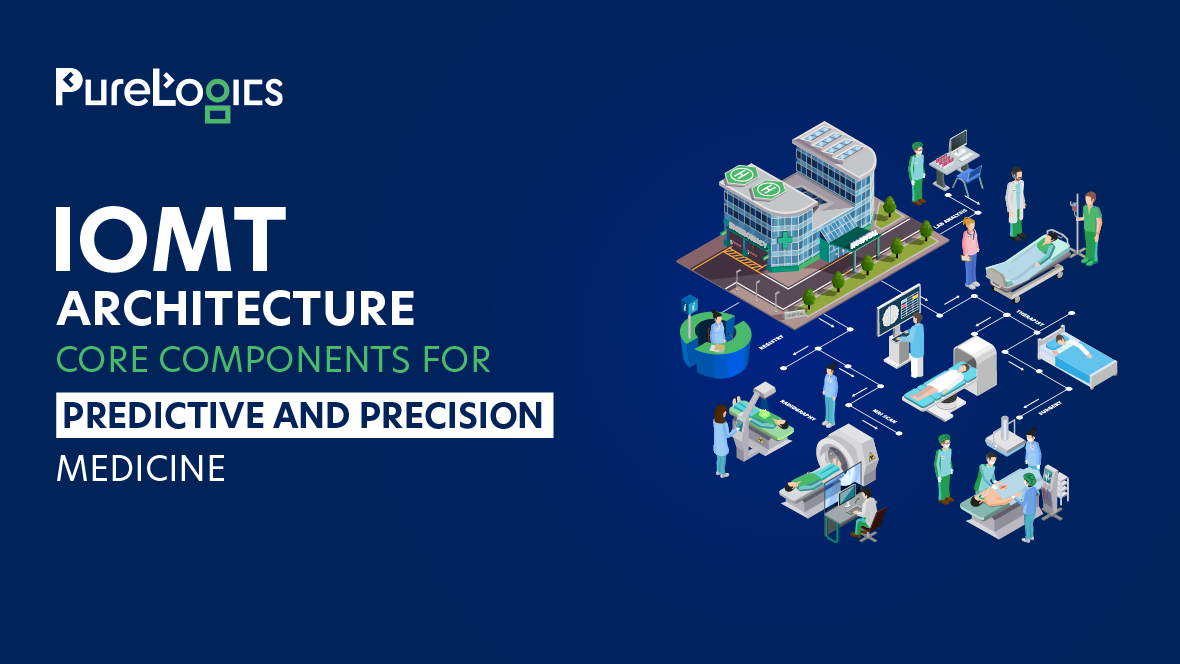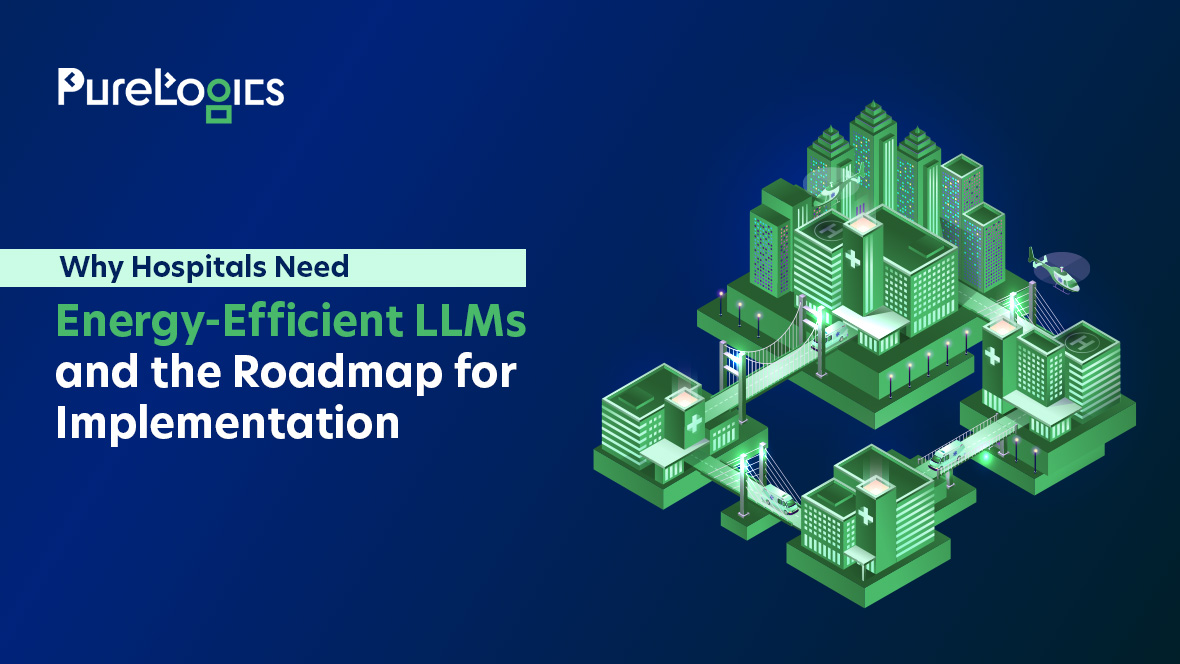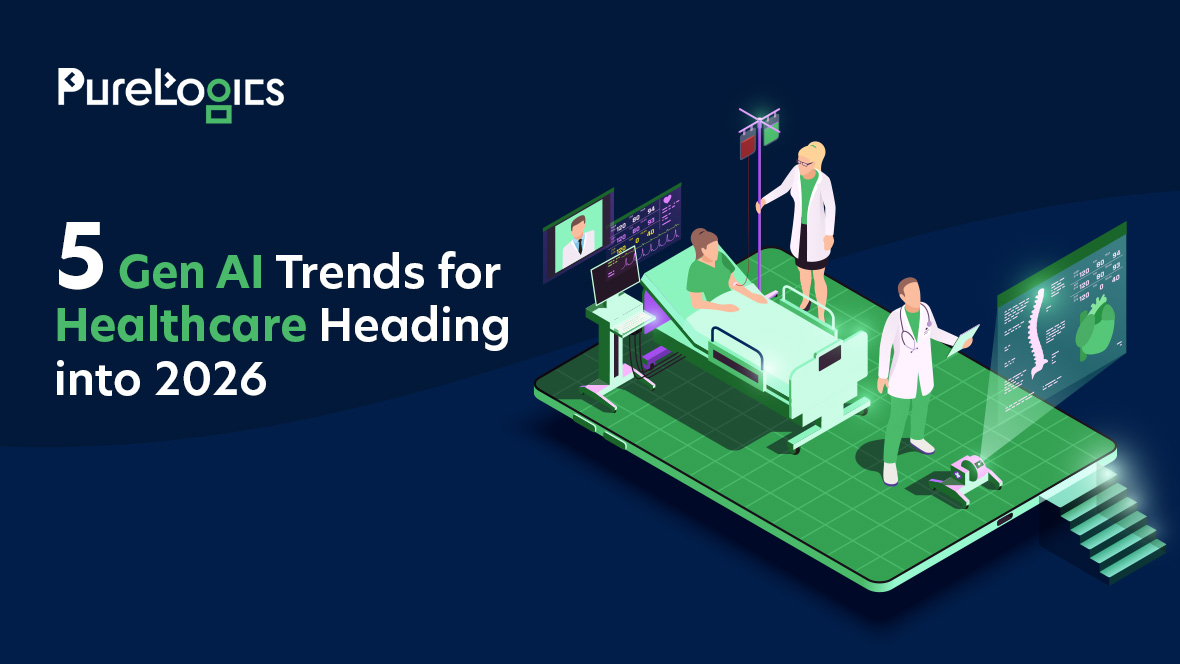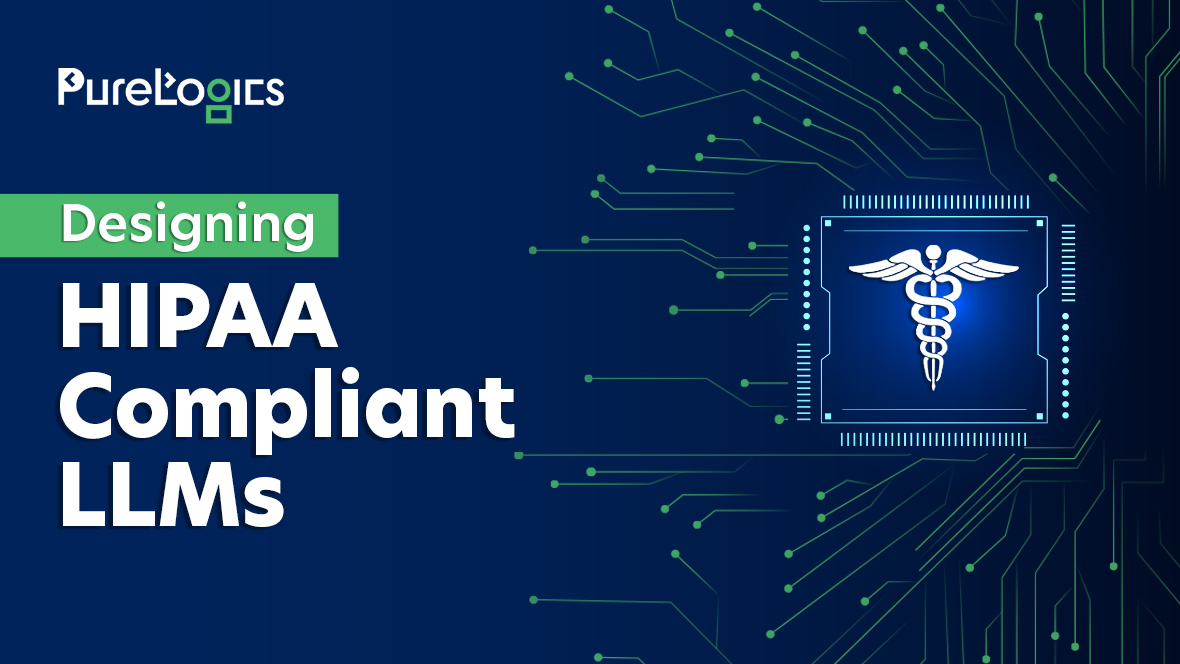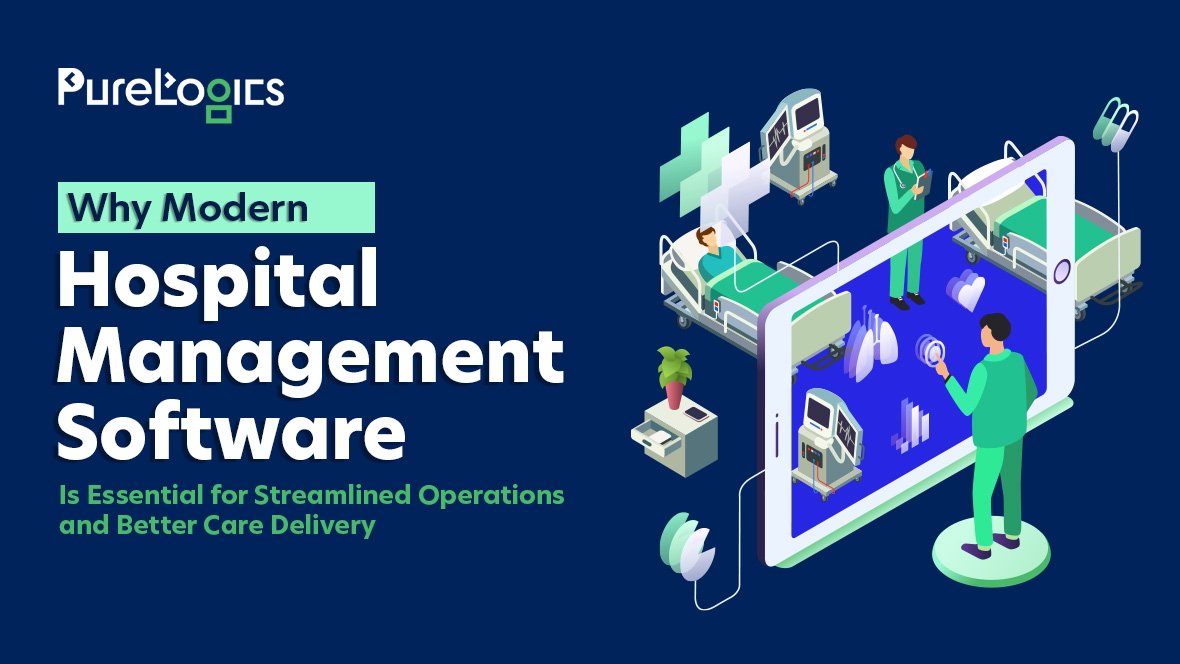Every day, in this busy healthcare ecosystem, physicians juggle rising patient loads and the pressure to handle precise, personalized care. However, critical data, from vital signs to medication adherence, often arrives too late because it is stored across disconnected systems. This is where IoMT in healthcare is becoming a powerful solution. You might be thinking… What is IoMT? Then imagine a world where patient monitoring devices alert you before symptoms appear, or where wearables and smart infusion pumps collaborate to predict complications, offering a real-time view of the patient’s health.
If you want to learn more about IoMT or want to integrate it in your existing systems. Then, in this piece, let us tell you how IoMT can serve your healthcare facility, and once you are finished, you will also know about:
- How does IoMT work? Core components and architecture.
- Its role in predictive and precision medicine.
- Benefits and proven examples of its implementation.
Extra Takeaway: Read five easy steps to implement IoMT, along with tips to ensure the security of your IoMT system.
What is IoMT?
IoMT in healthcare, or Internet of Medical Things (IoMT), is an interconnected network of devices and applications that gather, exchange, and analyze health data in real-time. It includes wearables, remote monitors, smart implants, and software systems. All in all, it can help enhance care delivery, diagnostics, and patient monitoring both outside and inside clinical settings. It can be confusing to understand the utility of IoMT from a hospital or patient perspective, so let us explain it to you.
- IoMT in the hospital: It is crucial for hospitals to manage the quality and supply of their medical assets, and they also need to track the movement of patients. Here, the healthcare professionals use IoMT sensors to track assets and monitor patients. This helps the administrator get a comprehensive view of what’s going on.
- In-home IoMT: The IoMT at home enables patients to transfer medical data (from their home) to their care providers or hospitals. For instance, remote patient monitoring involves the use of medical devices to transmit patient vitals, such as blood pressure or oxygen saturation levels. Another example is IoMT, along with telehealth, which can help maintain continuity of care outside the patient setting.
- On-body IoMT: This refers to the use of wearable medical devices which anyone can purchase to track health metrics for both personal use and to share health data with healthcare providers.
IoMT has multiple applications, which have led to its widespread adoption and growth.
Rise of IoMT Market
The advances in connected medical devices and the increasing demand for real-time patient monitoring have resulted in the significant growth of IoMT. Moreover, the healthcare providers are increasingly investing in it to enhance patient outcomes, which reduces hospital readmissions and improves operational efficiency.

IoMT does more than just data collection, as it also facilitates the analysis of data, which aids in the early detection of diseases. It can also customize treatment and care plans based on genetics, lifestyle, and environment.
Key Uses of IoMT in Healthcare: Predictive and Precision Medicine
IoMT allows tracking of patient data, facilitating the early detection of warning signs, supporting personalized care, and predicting risks. Below are the uses of this technology in predictive medicine and precision medicine.
Predictive Medicine
This helps identify risks and prevent illness before symptoms appear, and IoMT can be particularly helpful by enabling real-time remote monitoring.
- Remote monitoring: IoMT continuously tracks patient vitals to help predict any anomaly or even acute deterioration.
- Predict disease: IoMT collects data that AI can process to detect early conditions of disease.
- Prevent readmission: Home monitoring and wearables help prevent or predict patient readmissions, especially after treatment for chronic illnesses.
- Targeted interventions: IoMT helps in identifying high-risk patients by feeding data into predictive models for targeted interventions.
- Disease outbreaks: The data collected from devices helps predict community-level diseases or hospital-acquired infections.
Precision Medicine
IoMT, by collecting data from devices, helps doctors develop customized treatments and provide targeted care.
- Personalized care: IoMT not only collects medical data but also behavioral, physiological, and genomic data to help medical professionals provide personalized care.
- Tracking of medication: Biosensors and automatic pill dispensers help in tracking patients’ adherence to medication.
- Therapeutic monitoring: Devices track the response to treatment and adjust dosages or settings accordingly.
- Genomic devices: IoMT devices incorporate genomic data to enable healthcare professionals to recommend drugs or do interventions based on individual genetic risk profiles.
Indeed, IoMT has completely reformed the healthcare system by diverting it more towards predictive and precision medicine. However, other benefits, such as real-time monitoring etc, have also contributed to its widespread adoption.
Top Benefits of IoMT in Healthcare
IoMT enhances care quality, reduces hospital readmissions, and facilitates smarter clinical decision-making. This helps reduce the overall cost of care, and some of the other advantages are given below.

- Real-time monitoring: IoMT devices continuously monitor patient vital signs, identify abnormalities, and send instant alerts to healthcare providers, enabling proactive care. This is particularly useful in managing chronic conditions.
- Data analysis: IoMT devices collect data, enabling healthcare professionals to analyze it effectively. With the integration of AI, doctors and healthcare professionals can predict diseases and develop personalized treatment plans tailored to individual patients.
- Efficient health checks: Wearables and remote patient monitoring devices enable healthcare providers to remotely check the health status of their patients. This reduces the need for frequent health visits.
- Enhanced connectivity: IoMT supports connectivity between devices, ensuring the smooth exchange of data and thereby improving overall efficiency in smart healthcare software development.
- Faster Responses: IoMT holds great importance in emergencies because IoT-connected emergency rooms and ambulances provide patient data before arrival. This helps speed up the life-saving procedures and interventions.
Indeed, IoMT in healthcare has impressive benefits but they are only possible when the system integrated works fine behind the scenes. Let us provide you with a closer look at IoMT architecture, which enables its smooth functioning.
How does the Internet of Medical Things (IoMT) Work?
The integration of technology in healthcare has improved patient outcomes, including better efficiency with data-backed decision-making. Similarly, IoMT in healthcare connects medical devices, such as pumps and wearables, to the internet for data collection and transmission.
This helps in assessing real-time patient data metrics and automates care as needed. The IoMT core components, which enable smooth functioning include medical devices and sensors, connectivity modules, data storage and cloud infrastructure, IoMT software, healthcare interfaces, and, most importantly, the security and compliance layers.
Although we have divided this functionality into three layers, here’s how IoMT works:
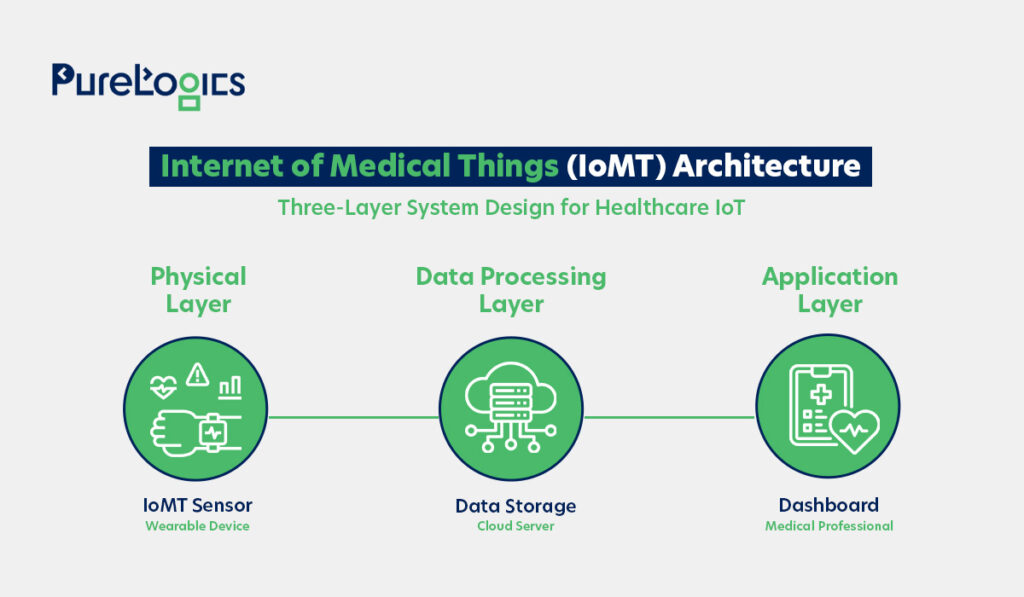
Physical Layer
This is the point where it all begins! The devices like smartwatches, wearables, ECG monitors, or glucose trackers are placed on or in the patient’s body. These devices continuously collect data, including heart rate, oxygen levels, temperature, and blood sugar levels.
Information Integration Layer
In this layer, the data is stored and processed, is sent to a central server or cloud platform. The data here is stored in a database and processed to identify patterns or health issues, such as irregular heartbeats.
Application Service Layer
Doctors or healthcare staff access and use this health data through monitoring systems, such as dashboards on their computers or tablets. Additionally, healthcare staff receive real-time alerts in the event of an emergency or abnormality, which enables them to make timely decisions regarding treatment or intervention.
IoMT in healthcare is bringing a revolution due to its three-layered powerful architecture, which ensures the smooth transmission of data. This reliable structure is beneficial for real-time monitoring and diagnostics and also supports smarter decision-making in clinical settings.
These capabilities are also highly reflected in the real-life applications of IoMT, especially in healthcare. Let us provide some tips to secure your IoMT, and then we will move on to the real-life applications of IoMT in healthcare.
Tips to Secure IoT Devices in Healthcare
There are security risks involved when it comes to IoMT implementation, but this challenge can be solved by taking the following steps:
- Zero-trust security model: Users and IoT devices must be authenticated before accessing hospital networks.
- Encryption & Tokenization: Ensure that data is securely stored and transferred to prevent interception of sensitive information.
- AI-Based Threat Detection: The Machine Learning (ML) algorithms can detect suspicious activity in real-time and block unauthorized access.
- Network Segmentation: You need to isolate IoT devices on separate networks to limit access so a breach in one device does not expose the entire system.
These measures can help you safely implement IoMT in healthcare; however, any discrepancy can lead to financial loss and tarnish your reputation. Therefore, it’s better to seek the assistance of healthcare software developers who can facilitate the risk-free implementation of IoMT.
Real-Life Application of IoMT in Healthcare
IoMT has truly revolutionized healthcare by connecting medical devices, which helps in the smooth exchange of data as well as its collection. This helps healthcare providers make data-driven decisions. Let us tell you about a recent study in Scientific Reports, which mentions the system called EHRGuard that combines IoMT and blockchain technology. This system in the research study tackled key challenges such as data privacy, trust, and interoperability.
In this setup, the patient wore medical devices, such as sensors, that monitored heart rate, glucose levels, and oxygen saturation. These IoMT devices sent real-time health data to a small, local gateway device, such as a Raspberry Pi, instead of storing this data on a blockchain, which is time-consuming and costly, thus utilizing a more efficient approach. So, the data was first saved in a secure off-chain database, and then only a cryptographic fingerprint (hash) of the data was saved on the blockchain. This helped ensure the data is tamper-proof while protecting the privacy of personal details.
All in all, this study is the perfect example of IoMT and how its integration with blockchain can increase transparency. Furthermore, EHRGuard required consent before any data was modified or accessed also ensuring that only authorized users can view or handle health data.
IoMT in healthcare is evolving through research and real-world innovations. Studies like these highlight their potential for secure and efficient data management. While devices like wearables are making a measurable impact, together as they reflect the growing influence of IoMT across the healthcare landscape. Before we move on to a proven example, let us walk you through the five easy steps to implement IoMT in your systems.
5 Steps to Implement IoMT in Healthcare
Here are the steps to implement IoMT successfully in your healthcare system to get real-time results.

Assess Your Needs
This is the first and the most crucial step. Here, you have to evaluate your needs and identify areas or departments where IoMT can bring improvements. The areas you can focus on are:
- Patient monitoring
- Chronic disease management
- Emergency response coordination
- Ambulance connectivity to hospital systems
- Telehealth & remote care
- Environmental monitoring
Choose IoMT Devices & Tech
Select IoMT devices, such as sensors or other appropriate medical devices and technologies, that align with your use cases. You must consider factors such as compatibility, reliability, regulatory approval, and integration capabilities.
Implement IoMT Solution
It’s time to implement IoMT on selected devices, and a key tip is to start with pilot programs before full-scale implementation to detect and resolve any issues.
Integration of Data Protection Measures
Implement robust cybersecurity measures to ensure HIPAA compliance and protect patient data. You can establish encryption, access controls, and data governance policies to ensure the security and integrity of your data.
Monitoring & Evaluation
Track performance metrics and gather feedback to make necessary changes. Ensure that you regularly update your security measures to optimize system performance and maintain optimal security.
By following these steps, you can effectively integrate IoMT in healthcare systems. Let us also tell you the innovative ways in which IoMT is being implemented.
Proven Examples of IoMT in Healthcare
Medical devices are improving patient monitoring, treatment, and overall care delivery, giving measurable clinical benefits. Some of the innovations that are helping healthcare professionals and patients are given below:
Smart Inhalers
Asthma and COPD affect millions of people worldwide, and smart inhalers are becoming a popular choice for patients. These inhalers, integrated with IoMT, are equipped with sensors that monitor usage and transmit real-time data to connected systems. Furthermore, for patients, they provide timely reminders and track dosage. At the same time, for healthcare providers, they offer deeper insights into usage patterns, allowing them to create personalized treatment plans, which in turn lead to fewer flare-ups.
Connected Contact Lenses
These smart lenses are not for correcting vision, but they continuously track glucose levels in tear fluid and transfer this data to a real-time connected device. This enables better day-to-day management of diabetes and allows for immediate intervention in the event of fluctuations in blood sugar levels.
AI-Based IoMT Software
These solutions enable real-time monitoring of patients, allowing healthcare providers to track vital signs and adherence to medication. Additionally, the integration with electronic health records ensures a smooth data flow, enabling physicians to make informed decisions. The advanced features, such as AI-powered analytics, can help predict health risks and abnormalities early, before the conditions worsen.
Wireless Blood Pressure Monitors
These devices not only measure blood pressure but also transfer readings to smartphones or healthcare systems, thereby developing a digital health log. This real-time connectivity provides patients with feedback and enables healthcare professionals to stay accurate and up-to-date with health data, facilitating timely interventions and informed decision-making.
Bluetooth-Enabled Digital Thermometers
These Bluetooth-based devices record readings and transmit them to smartphones or cloud platforms. It helps patients consistently monitor their temperature, providing healthcare professionals with continuous data to assess patterns or early warning signs.
Smart Glucometer
These smart devices measure the glucose levels and sync smoothly with smartphones or cloud platforms. This helps the patients track trends, make informed choices, and send data to their healthcare provider. All in all, they convert the scattered data into meaningful insights, making diabetes management easier.
Smart Beds
The smart beds integrated with IoMT help monitor sleep cycles, heart rates, and breathing patterns. It provides physicians with valuable insights into sleep quality, enabling them to make precise diagnoses and identify issues such as sleep apnea, insomnia, and irregular sleep patterns.
With these applications, the future of IoMT in healthcare is promising, with the potential to transform the healthcare ecosystem into one that prioritizes proactive and predictive care.
Future of IoMT in Healthcare
IoMT will have widespread applications in healthcare sector, enabling healthcare providers to gather and analyze data, as well as patients to view their data in real-time and make informed decisions.

Smart Hospital Ecosystems
The expansion of IoMT in smart hospitals includes interoperable devices, RFID-based asset tracking, and robotic aids for automation.
Advanced Telemedicine and RPM
Telemedicine and RPM will utilize IoMT tools, such as wearables and smart patches, to enable continuous and personalized care.
AI and Machine Learning
IoMT in healthcare will heavily depend on AI and ML to enhance predictive analytics, personalize patient care, and automate decision-making processes.
Big Data Analytics
IoMT devices generate large amounts of data, and by utilizing data analytics, this data can reveal trends, monitor diseases, and track the results of treatment.
The growing adoption of IoMT in healthcare marks a significant shift in how healthcare is delivered and managed. But it is essential to consider the complexities that can arise in its application.
Challenges in Implementing IoMT in Healthcare
With benefits, the IoMT implementation can come with its fair share of issues. Some of the common challenges you can come across are given below:
Privacy & Compliance
Healthcare systems that contain patient health data are complex and delicate. That’s why their compliance with data protection regulations, such as HIPAA and GDPR, is necessary. However, ensuring compliance can be challenging, and you need to have a comprehensive strategy that facilitates continuous monitoring of IoMT. Moreover, navigating the regulatory landscape for IoMT devices can be challenging, primarily due to the overlap between hardware and software, as well as the complex data handling requirements that these devices entail. In the US, generally, the FDA approval is required for IoMT devices (if their function is to diagnose, treat, or prevent disease).
All in all, this can be confusing, and it’s better to hire a healthcare software development company. They ensure compliance and facilitate the smooth integration of software by providing trainings.
Interoperability Challenges
The development of IoMT devices can pose significant interoperability challenges. This is primarily due to the lack of universal standards and the fragmented nature of healthcare systems. Moreover, integrating IoMT with EHRs can be tough, and implementation inconsistencies can lead to compatibility issues. Additionally, the adoption of universal healthcare standards, such as HL7 FHIR, ensures consistent application across various devices and systems.
Financial Issues
The implementation of IoMT software can be expensive due to the costs associated with integration, compliance, and maintenance. However, hiring an experienced custom healthcare software development company can help you manage costs by using modular, cloud-based solutions with a focus on scalable deployments that support the hospital’s existing IT infrastructure.
Resistance to Change
The acceptance of IoMT in the healthcare system can pose resistance, which can hinder its successful implementation. However, many healthcare software development companies like Purelogics offer comprehensive training and education programs to familiarize the healthcare staff with IoMT functionalities.
Key Takeaway
The implementation of IoMT in healthcare is not without challenges, and improper integration can expose a healthcare facility to numerous issues. A survey of 500 hospitals revealed that 43% of respondents experienced at least one ransomware attack on their IoMT devices. That’s why correct implementation is the need of the hour and can help healthcare facilities save up to $27,000 per patient via RPM (Business wire). With nearly 20 years of experience, PureLogics has helped healthcare providers overcome these barriers, enabling care facilities worldwide to leverage the benefits of IoMT. Our experienced healthcare software developers ensure scalability, security, and compliance with HL7 and HIPAA. Whether you’re laying the foundation, choosing the IoMT devices, or integrating them into your existing systems, we’ve got you covered. Contact our experts for effective implementation of IoMT or learn more about our healthcare services.
FAQs
What are the examples of IoMT?
A typical example of IoMT is wearable devices, such as smartwatches, that monitor heart rate and ECG in real-time, in addition to remote monitoring tools that track vital signs (send alerts),smart infusion pumps and connected imaging systems used in hospitals for accurate and data-driven care.
What are the challenges of IoMT?
The main challenges to IoMT adoption are interoperability, privacy, security, network latency, and energy consumption. These issues can be solved through standardized protocols, robust cybersecurity measures (such as encryption and access control), efficient data management, and high-speed network infrastructure.
What is the cost of integrating IoMT in healthcare?
The cost is based on factors such as device complexity, software customization, data security, and cloud setup. Moreover, the basic implementation can range from $30,000 to $300,000, depending on the features.
What are the examples of IoMT devices?
Glucose monitors, smart inhalers, smart pill dispensers, RFID inventory management devices, smart beds, connected contact lenses, and Bluetooth-enabled digital thermometers.


 [tta_listen_btn]
[tta_listen_btn]
 July 15 2025
July 15 2025

